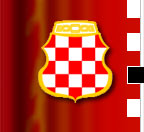| 1878.
After
the Russo-Turkish war, the Berlin Congress has been held,
ending with the decision that Bosnia-Herzegovina, which was
formally still under the Turkish suzerainty, would be occupied
by Austria-Hungary and subdued to its jurisdiction. The Austrian-Hungarian
units, numbering 82,000 men, met the resistance of weakly
organized, predominantly Muslim militia of 40,000 soldiers
(along with a number of associated Orthodox chieftains) led
by Sarayevo's agitator Hadzi Lojo. The main Austrian forces,
so called "occupying units" of 9,400 soldiers under
the command of a Croat, baron Josip Filipovic, have quickly
broken in through northern Bosnia, conquering Banja Luka,
Maglaj and Jajce. After the battle at Vitez in central Bosnia,
in which they have decisively defeated the Bosnian Muslim
army, Filipovic's forces have taken Sarajevo (breaking the
severe resistance of local Muslim population ), and advancing
further through Herzegovina and NoviPazar Sanjak have occupied
the entire Bosnia-Herzegovina. The conquest has lasted for
less than three months, during which the overall losses of
the Austrian units amounted to 946 dead and 3980 wounded soldiers.
Considering the bad condition of the roads, in accordance
with one of the contemporaries it can be concluded that Austria
has occupied Bosnia-Herzegovina in a time soldiers needed
to tramp it from end to end.
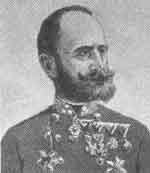
Josip Filipovic, Austrian vice-marshal and Croatian baron,
the head of
Bosnia and Hercegovina occupation troops
1878.-1918.
Austrian
administration in Bosnia-Herzegovina.
The most
pervasive processes that shaped the society and history in
that period were:
--the
definite re-inclusion of Bosnia-Herzegovina into the European
cultural and political milieu. Since 1878. BiH and its nations
are a part of the European order, their destiny tied to European
ideologies, conflicts and geopolitical designs.
--the
final crystallization of Bosnian-Herzegovinian Croats and
Serbs, from ethnical/religious to modern political entities,
or from peoples to nations, integrated into the national corpus
together with their compatriots outside of BiH. Considering
that the most nations of the Middle, North and East Europe
have undergone this process in the post-Napoleonic period
(the most intensely around 1850., with the exception of Scandinavian
nations, Finns and Norwegians, whose national renaissance
has had the apex in the second half of the19th century), the
Croats and the Serbs of Bosnia-Herzegovina were "latecomers",
with the delay of circa 50 years. However, once initiated,
the process of national crystallization and homogenization
turned out to be irreversible. Anguished over the separation
from the Ottoman empire and faced with an alien, Christian
and Western, imperial authority, the Bosnian Muslims reacted
in two ways:
a) a part
of them (according to some estimates, circa 100,000 people)
moved to Turkey for good
b) the
rest of them have reluctantly acknowledged the Austrian suzerainty
and tried to get along with it, either by insisting on the
preservation of the status quo (the majority of Muslim gentry),
or by accepting/succumbing to the Western-style modernization
--during
that period, three national ideologies (among which two of
them turned out to be quasi-national) "struggled for
the souls" of the Croats, Serbs and Bosnian Muslims:
a) the
first was the ideology of the already established nations,
the Croats and the Serbs. Along with massive lining up of
the BH Croats and Serbs into their respective "national
encampments", the Bosnian Muslims have set out on the
trek (one might say a trudge) for self-identity: the major
part of educated classes accepted the Croatian national ideology;
the lesser part conformed to Serbian national mythology, while
the rest of the intelligentsia and the majority of the common
people stayed aside, feeling in their bones the unbridgeable
separateness and distance from both Croats and Serbs, but
nevertheless unready to transform their budding aspirations
into articulate political and national programme of modern
type (although they have succeeded in creating a separate
political party as a sign of their permanent (but semi-conscious)
desire for actualized national identity).
b) since
1882., the Austro-Hungarian administrator of Bosnia-Herzegovina,
the Hungarian historian Benjamin Kallay, was attempting through
a methodical policy to enforce the term "Bosnian",
which would, supposedly, have "covered" all the
BiH inhabitants and served as the crucial catalyst in creating
the Bosnian "nation". Practically, this was manifested
in funding the pro-Bosnian publications, as well as in interdicting
or suppressing the Croatian and Serbian national associations.
However, this "nation-making" project, operated
in an administrative manner, with Muslim aristocracy as the
head office of the entire enterprise, was doomed to failure
from the outset-- all attempts to negate and uncreate the
already established nations (Croatian and Serbian) in Bosnia-Herzegovina,
resulted only in heightened tensions. The 1910. elections,
which turned into the "enrolment" of people into
their respective national camps/parties, have only confirmed
the failure of the Bosnian quasi-national programme. Historically,
it is an interesting phenomenon that ideology identical to
Kallayism resurfaced as a Bosnian Muslim ultra-nationalist
option at the end of the 20th and the beginning of 21st centuries.
This shows that bizarre political schemes/ghosts come back
to life in altered circumstances when, according to all rationalist
criteria, the ideological scrap is buried together with its
creator, in this case the Habsburg Monarchy.
c) the
ideology of Yugoslavism, or the South Slavs unity, originating
primarily in the circles of Croatian intelligentsia (bishop
Strossmayer, historian Franjo Racki et al.), has passed through
many mutations. From romantic idea of linguistic-cultural
communion of the South Slavs, encompassing the national lands
of the Slovenes and spanning to the Bulgarian soil, through
the Realpolitik strategy of the Croatian politicians at the
beginning of the 20th century (Supilo, Trumbic), to the smokescreen
of the megaserb expansionist territorial drive (similar to
the idea of Pan-Slavism as a Trojan horse of the Russian czarist
imperialism)- Yugoslav ideology became dominant among a tiny
fraction of the Croatian, Serbian and Muslim younger intellectuals.
However, what was lacking in numbers has been amply compensated
with feverish activity. The vision of a future happy and harmonious
Yugoslav state which will have naturally absorbed all of the
existing "Yugoslav" nations, and liberate the "tribes"
of the Croats, Serbs, Slovenes and still fuzzily defined Bosnian
Muslims from the hated Austrian yoke has become: (one, numerically
insignificant but historically decisive, branch) the guiding
ideal of the fledgling activists, who have speedily accustomed
to the assassins and terrorists role, and (another, more pragmatic
branch) a contradictory political programme of the Croatian
and Serbian politicians in the Habsburg Monarchy.
--the
moderate modernization of Bosnia-Herzegovina (the beginnings
of industrialization, reforms of the school system and social
relations,..), intended for keeping BiH as a separate, self-sustainable
administrative unit within the frame of Austro-Hungarian Monarchy,
but without radical measures which could break the balance
of relations in the Habsburg Empire. The general backwardness
(less than 15% of urban inhabitants, social and national antagonisms
(from the tally of 85,000 serf families, about 60,000 of them
were Serbian, and 25,000 Croatian. The number of Muslim serfs
was negligible)) had been blocking the implementation of even
reluctant reforms. The Habsburg Monarchy had not dared to
carry out the agrarian reform (which would mean taking away
much of the fertile soil from the Muslim aristocracy, which
has in the course of time, (ab)using the pragmatism and opportunism
of the Vienna Court, evolved from an adversary of Austro-Hungarian
Monarchy into one of the pillars of Austrian administration).
--the
strenghtening of the Serbian kingdom, especially after successes
in the Balkan Wars (1912-1913), as a client-state of the Russian
Empire fuelled the antagonisms between great European powers.
Also, Serbia's financial support of rapidly radicalized pro-Yugoslav
secret society "Mlada Bosna" ("Young Bosnia")
and the assassination of the Austrian Archduke in Sarajevo,
have resulted in World War I and the collapse of Austro-Hungarian
Monarchy.
1878.-1914.
Around
180-200 thousands of Croats, Slovenes, Czechs, Germans and
others have immigrated into Bosnia-Herzegovina, and around
100,000, mostly Bosnian Muslims, have emigrated.
1878.-1948.
Ante Alaupovic,
a priest, the chairman of the Croatian cultural association
"Napredak" in Sarajevo, the most significant Croatian
cultural society in Bosnia-Herzegovina.
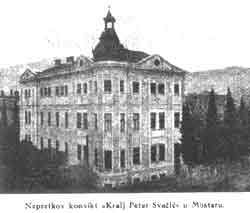
"King Petar Svacic" convent school in Mostar
cca. 1900.
1881.-1882.
The so-called "Herzegovinian uprising". Military
patrols in East Herzegovina attacked by local Serbian chieftains.
The rebels, around a thousand of them, surrendered to the
Austrian army, which numbered circa 4,000 soldiers in Herzegovina,
after the surround and encirclement.
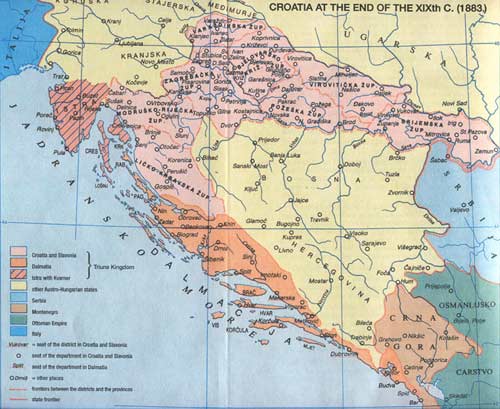
Bosnia and Herzegovina as a protectorate of the Habsburg
monarchy
1882.-1903.
The Kallay
regimen in Bosnia-Herzegovina. The systematic policy of Bosnian
unitarism, along with the rebuff of the Croatian and Serbian
national ideologies. The official introduction of "Bosnian"
language as a political measure to slacken the tensions of
Croatian-Serbian disputes has obtained, for the opportune
reasons, even a support from the Croatian linguist Vatroslav
Jagic, a professor in Vienna and Petersburg and the leading
world-wide authority in the field of the Slavonic studies.
However, the "linguistic experiment" has, just like
other experiments in culture and national "engineering",
fallen through. Kallay's "Bosnianhood" was evidently
a failed political project already at the end of the19th century.
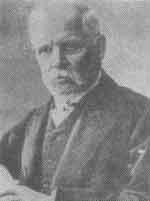
Vatroslav Jagic, the leading authority in Slavonic studies
1884.
In the
Franciscan monastery on Humac, nearby Ljubuski, the establishment
of a museum, the first one in Bosnia-Herzegovina.
1885.
The political
newspaper "Glas Hercegovca" (The Voice of Herzegovinian)
has been started. Its last issue came in 1896.
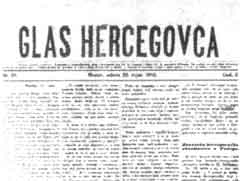
"Voice of Hercegovinian", a Croatian newspaper,
Mostar 1885.
1890.
The Supreme-Bosnian
archbishop (the somewhat pompous title of the oldest religious
office in Bosnia and Herzegovina) dr. Josip Stadler opened
the primary year of philosophical-theological studies in Mostar
on Sep. the 1st. This was the beginning of the higher education
system in Bosnia-Herzegovina.
1892.-1975.
Ivo Andric-
narrator, poet, novelist and the Nobel Prize winner.

Ivo Andric, Bosnian Croat novelist, a Nobel prize laureate
1895.
The national
structure of Bosnia-Herzegovina is as follows: out of 1,433,471
inhabitants, the Croats make up 21.31%, the Serbs 42.93%,
and the Bosnian Muslims 34.99%.
1889.-1973.
Dominik
Mandic, a Franciscan: a cultural, social and
political scholar and activist, one of the most prominent
Croatian historians and unavoidable authority on the medieval
Bosnia history.
1902.
The "Srbobran"
(meaning "Serbs's defender"), a messenger of the
Independent (Serbian) Party in Zagreb has published in its
August issue the article "The Serbs and the Croats",
penned by Nikola Stojanovic, and taken over from "Srpski
knjizevni glasnik" (Serbian Literary Messenger). In that
article, published under the title "To the Inquisition,
Yours or Ours", this Serbian public and cultural performer
endeavors to prove that the Croats are not a nation and that
they will ineluctably disappear: "This struggle must
continue to the inquisition, ours or yours. One of the two
must succumb. That this one will be the Croats, it is guaranteed
by their numerical inferiority, their geographical position,
the circumstance that wherever they live they are mingled
with Serbs, and the process of general evolution which invests
the idea of Serbianhood with the progress". The article
has provoked anti-Serbian outrage and demonstrations in Zagreb
on Sep. the 1st and 2nd, and also further embittered and poisoned
Croatian-Serbian relations, which had become fraught with
distrust and enmity, especially in the second half of the
XIX-th century following the expansion of mega-Serbian idea
"the Serbs all and everywhere" that contravened
everything non-Serbian in the territories Serbian strategists
eyed as a booty.
1906 -1998
Vladimir
Prelog, Croat from Sarajevo, later University professor in
Switzerald, the Nobel prize winner for chemistry in 1975.
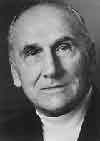
Vladimir Prelog, Bosnian Croat chemist, a Nobel prize laureate
1906.
The foundation
of Muslim People's Organization, the first political party
of Bosnian Muslims.
1907.
The foundation
of Serbian People's Organization, the leading party of Bosnian-Herzegovinian
Serbs.
1907.
The foundation
of Croatian People's Union, the first political organization
of Bosnian-Herzegovinian Croats, close to Starcevic's Party
of Rights.
1908.
The Annexation
crisis. When the Young-Turks's revolution prevailed in the
Ottoman Empire, Austro-Hungary got frightened that it would
have to return back the BiH, so it decided to annex and incorporate
the province directly into the Austro-Hungarian state organization.
This has provoked the Serbs's and Muslims's demonstrations,
as well as severe standoff from Serbia and Montenegro which
have threatened with a war, claiming that the BiH is, ostensibly,
theirs. Namely, Serbian politicians and ideologues have, according
to the "theory" of great-Serbianism (a variant of
provincial imperialism), claimed that all the Stokavian dialect
speaking Catholics and Muslims are, essentially (and "unconsciously"),
Serbs. Serbia and Montenegro were eventually calmed down by
their protector Russia, which informed them that it is not
yet ready to wage a war. In this way the annexation crisis
was solved only temporarily, by diplomatic means, but the
preparations for a showdown nevertheless continued. The terrorist
organization named "Unification or Death" (also
known as "Black Hand") has been founded in Belgrade.
1910.
The elections
with limited voting rights. In the Bosnian Parliament the
Serbs obtained 31 mandates, Muslims 24, and Croats 16 mandates.
The denominational structure of the population--out of 1,897,962
inhabitants, 43.5% are Orthodox, 32.4% Muslim, 22.8% Catholic
and 0.6% Jewish.
1912.-1913.
The Balkan
Wars. Montenegro, Serbia, Bulgaria and Greece have defeated
Turkish army and expelled it from Novi-Pazar "Sandzak"
(Turkish term, pronounced as "sanjak", meaning "a
province"), Kosovo and Macedonia. In the second round
Serbia, with a help from the allies, routed Bulgarian army.
Pogroms of Albanians, Macedonian and Turkish Muslims in the
conquered areas followed thereafter.
1914.
The Archduke
Franz Ferdinand assassinated in Sarajevo on June the 28th,
together with his wife, Archduchess Sophia. Since the assassination
was organized by pro-Serbian organization "Mlada Bosna"
(the assassin Gavrilo Princip had been trained in terrorist
organizations in Serbia and connected to Serbian intelligence
service, headed by colonel Dimitrijevic-Apis), the assassination
was a pretext for a war declaration which the Habsburg Monarchy
announced to Serbia. This resulted in World War I, in which
Croats have taken part on the battlefields from Montenegro,
Serbia and Galicia to Italy and the Ardennes.
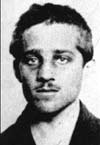
Gavrilo Princip, Bosnian Serb terrorist
1914.-1915.
In spite
of heavy losses, Serbia has held out and pushed back the offensives
of the Austrian army under the command of general Potiorek,
on the area covering the Serbian side of the Drina river.
Late that summer, the Serbian army was defeated by united
Austro-Hungarian and German armies, and has retreated over
the northern Albania mountains to the Allies military bases
in Greece.
1914.
The Croatian
politicians (Ante Trumbic, Frano Supilo, Ivan Mestrovic, Hinko
Hinkovic, Franko Potocnjak), the Serbian politicians from
Bosnia-Herzegovina (Nikola Stojanovic (the infamous "Srbobran"
author) and Dusan Vasiljevic) and the emissary of the Serbian
government (headed by Nikola Pasic) Pavle Popovic, have come
to an agreement on the foundation of Yugoslav Committee in
Florence on Nov. the 22nd, with the task to struggle for the
creation of a unified Yugoslav or possibly Serbo-Croatian
state, depending on the agreement between Yugoslav Committee
and the government of the Kingdom of Serbia. At the meeting
the Montenegrin observer Lujo Vojnovic was present too. The
Committee was constituted in Paris Apr. the 30th, choosing
London for its permanent residence. The political activity
of the Yugoslav Committee developed in very unfavorable circumstances,
reflecting the different standpoints of the Yugoslav Committee
and the Serbian government on the means and aims of creating
the future common state.
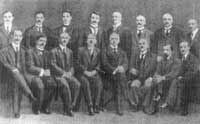
The Yugoslav Committee
1917.
A series
of battles with Italy, which was defeated by Austro-Hungarian
and German army at Kobaridi (Caporetto), commenced at Soca.
In these battles the Croats, Muslims, Slovenes and Serbs from
Austro-Hungary have shown great valor and endurance, enraged
and motivated especially by Italian irredentist claims on
the Croatian and Slovene lands.
1917.
One of
the most significant Croatian politicians of the century's
turning-point, Frano Supilo, passed away in London. He had
left the Yugoslav Committee disillusioned by its growing Serbian
expansionist slant, but had nevertheless, in Nis, Petersburg,
London and Paris undertaken everything possible against joint
intrigues of Italians and Serbian premier Pasic to divide
Croatia.
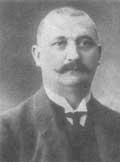
Frano Supilo, Croatian politician
1917.
The representatives
of the Yugoslav Committee and the Kingdom of Serbia, on Corfu,
have signed the so-called Corfu Declaration on the Union and
Future Common Arrangement of the State. According to this
agreement, the future state of the Serbs, Croats and Slovenes
should have been a constitutional, democratic and parliamentary
monarchy headed by the Serbian Karadjordjevic dynasty.
1914.-1918.
According
to some estimates, the demographic loss of the Bosnia-Herzegovina
populace, including war losses and emigration, amounts to
circa 300,000 people.

|
